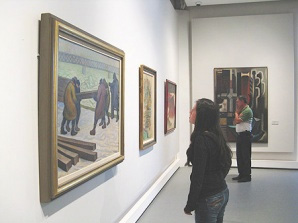In Mexico, Artists Can Pay Their Taxes with the Stroke of a Brush
 Chris Hawley - azcentral.com Chris Hawley - azcentral.com
go to original
April 13, 2010


| | A visitor looks at “Containing the Ice of the Danube in Bratislava,” which Mexican painter Diego Rivera used to pay his income taxes one year, at the museum of the Ministry of Finance and Public Credit in Mexico City. (Chris Hawley/Arizona Republic) |  |
Mexico City - Can't afford to pay your income taxes? Paint a picture instead.

That's the deal Mexico has offered to artists since 1957, quietly amassing a modern art collection that would make most museum curators swoon.

While April 15 is the deadline to file taxes in the U.S., tax collectors in Mexico are getting ready to receive a whole new crop of masterworks.

"It's really an amazing concept," said José San Cristóbal Larrea, director of the program. "We're helping out artists while building a cultural inheritance for the country."

There's a sliding scale: If you sell five artworks in a year, you must give the government one. Sell 21 pieces, the government gets six. A 10-member jury of artists ensures that no one tries to unload junk on the government.

Thanks to the program, the Ministry of Finance and Public Credit now owns 4,248 paintings, sculptures, engravings and photographs by Diego Rivera, Rufino Tamayo, Leonora Carrington and other masters and renowned artists.

It displays these treasures in Mexican museums, hangs them in government offices and, increasingly, lends them out for special exhibitions around the world. Others are stored in a huge, climate-controlled warehouse in Mexico City.

Forget 1040 forms - there's nothing boring about these tax returns. There are genitals and sex scenes, violence and political satire galore. Clerks dutifully post each artwork on the tax-office Web site, and the agency hangs them proudly in its own museum in downtown Mexico City.

"There's no censorship here," said Julieta Ruiz, a curator at the museum.

If anything, the temptation to needle the taxman makes the art even edgier, she said.

Rafael Coronel's 1980 tax payment is a wistful portrait called "He Who Doesn't Pay Taxes."

A painting that Fabian Ugalde contributed in 2002 declares in huge letters, "The authorities have still not determined whether it was an act of aggression or just another piece of art."

A 10-foot-high drawing by Demián Flores shows a man sexually assaulted by a rattlesnake, an apparent reference to the Mexican government because the rattlesnake appears on the Mexican flag.

The art program was the brainchild of two painters, muralist David Alfaro Siqueiros and Gerardo "Dr. Atl" Murillo. In 1957, an artist friend of theirs was about to go to jail over tax debts, so the two men approached Mexico's tax director and talked him into an art-for-amnesty deal.

Soon, the tax office was accepting original art on a regular basis. In 1975, the Payment in Kind Program became an official part of the tax code.

Bill Brunson, a spokesman for the Internal Revenue Service in Phoenix, said he was unable to determine whether any similar program exists in the U.S. Most people pay their taxes in this country with a check, credit card, money order or other "commercially acceptable" form of currency.

In Mexico, not everyone can pay with art. Participants must register with the Tax Administration Service, Mexico's version of the IRS, by submitting a body of their work to the jury and proving they have shown or sold artworks.

About 700 artists are registered, though not all of them pay with art every year, San Cristóbal said.

The roster includes foreigners living in Mexico, including artists Melanie Smith of Britain and Alonso Mateo of Cuba.

The artworks are collected at eight regional offices ahead of Mexico's April 30 income-tax deadline. Then the jury, which changes every two years, rules on the quality of the pieces.

Most past muster, but a few well-known artists have had their contributions rejected in recent years, San Cristóbal said. He declined to name names.

The program is only for visual art, not music or literature. Administrators may soon accept performance art as well, San Cristóbal said. Artists would have to submit videos, photographs or other artifacts of their performance that the government could store and display, he said.

The collected artworks are divided equally among the federal government, Mexico's state governments and its municipal governments.

Many have soared in value since the artists handed them over. A piece by world-famous muralist Rivera that was valued at $50,000 in the late 1950s is now worth millions of dollars, San Cristóbal said.

By law, however, the government cannot sell any artworks from the collection. The artworks become protected "cultural-heritage objects." But there is also a more practical reason: If the government made a profit, it would have to give the artists a tax refund, San Cristóbal said.

The tax office publishes colorful catalogs of its collection and maintains a Web site where visitors can see what artists have contributed each year, along with the location of each work.

Asked which contemporary artists he would like to add to the tax office's collection, San Cristóbal's eyes lit up.

"Oh, I'd love to have a Gabriel Orozco," he said, referring to one of the country's hottest sculpture and installation artists. Then, he sighed.

"But Orozco lives in New York now. He pays American taxes."

Reach the reporter at chris.hawley(at)arizonarepublic.com. |



